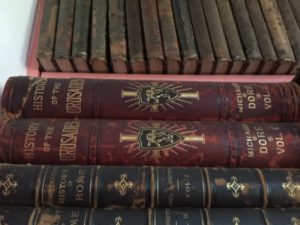 E sent me two volumes of the History of the Crusades Illustrated in One Hundred Grand Compositions by Gustave Dore, written by Joseph François Michaud, published by George Barrie, Philadelphia, in 1890. Michaud WROTE the book in 1811 in Paris.
E sent me two volumes of the History of the Crusades Illustrated in One Hundred Grand Compositions by Gustave Dore, written by Joseph François Michaud, published by George Barrie, Philadelphia, in 1890. Michaud WROTE the book in 1811 in Paris.
In the First Crusade of the early years of 1000 C E came: “I, or rather the Lord, beseech you as Christ’s heralds to publish this everywhere and to all people of whatever rank, foot-soldiers and knights, poor and rich, to carry aid promptly to those Christians and to destroy that vile race from the lands of our friends. I say this to those who are present, it is meant also for those who are absent. Moreover, Christ commands it.” So wrote Pope Urban II in 1095. Medieval Crusades that followed his orders became a polarizing event in history, a myth still not understood by the “modern” world. The revitalization of this great story through the ages, its retelling solidifies the power of the Crusades in historical memory.
The value of the two volumes, $1,000, is one thing. The real story involves WHY the history of the Crusades got revived first, in Paris, in an edition illustrated by Dore in 1875, and then in Philadelphia in 1890.
Often reprints of books come out because the climate of the time resonates with the book. This happened with E’s History of the Crusades.
What happened in the First Crusades?
The Franks (the French) took Jerusalem by storm on July 15, 1095 and massacred most of the population including Muslims, Jews, and Christians. The French Crusaders stayed on the warpath for almost three years to no avail. The defeat of Jerusalem established an alien colony for them. The Franks took territory from the Turks, too. Perhaps the world’s first example of colonialism, or the exercise of medieval beliefs of recapturing of a mythical land for a “superior” power under God.
Why did Michaud write this book about this mythical Crusade in 1811? As a Royalist he supported the Bourbons in the French revolution. He edited pro-crown journals, got arrested and sentenced to death by the French Military Council. After a prison stay he shied away from journalism, and began his History of the Crusades. Under a Pope and a King, the Franks prevailed THEN in the 11th century Michaud became fascinated by this period of the medieval Crusades. He wrote on it extensively, argued about its importance with intellectuals of the time. Then journeyed to Syria and Egypt 1830-1831 to research for a further book on the Crusades. He died in 1832.
Telling the History of the Crusades in 1875
Hachette and Company reprinted the lavishly illustrated book in Paris in 1875. France needed a memory of its noble past under King and Pope. They trudged through the Franco-Prussian War 1870-1871. Then the fall of Napoleon III in 1870, after which the government of the Third Republic rebuilt the country. They believed colonialism a RIGHT. France took territory in Indochina, Madagascar, Polynesia, and West Africa. The Prussians took the French Territories of Alsace and Lorraine in reparation from the Franco-Prussian War. Conquest all around…and of course, the reprinting of the book in Philadelphia of 1890 was significant. The US saw itself as the next great superpower, with might and right on its side. The American ultra-rich and ultra conservative industrialists also felt that way.
Thus, the themes Michaud wrote about, which supported his beliefs in the glories of the Crusades, The History of the Crusades in 1811 re-echoed significant themes in its re-publication in the France of 1875 and America in 1890 . These themes chronicle the monarchy vs. republic, religious right vs the OTHER, the Holy Army, the conquest of territory in the name of ‘superior power,’ echoed in the revitalization of this one book. History repeats itself, thematically, as well as literally.
E asked what made an old book valuable. I’m not an expert, but I identified some factors: a tight binding, unmarked pages, bright engravings, tissue over the engravings, very little foxing caused by damp and acid burn, marbled end pages, gilt titles and raised bands on a leather spine. Those are the material aspects; there’s the symbolic aspect as well!